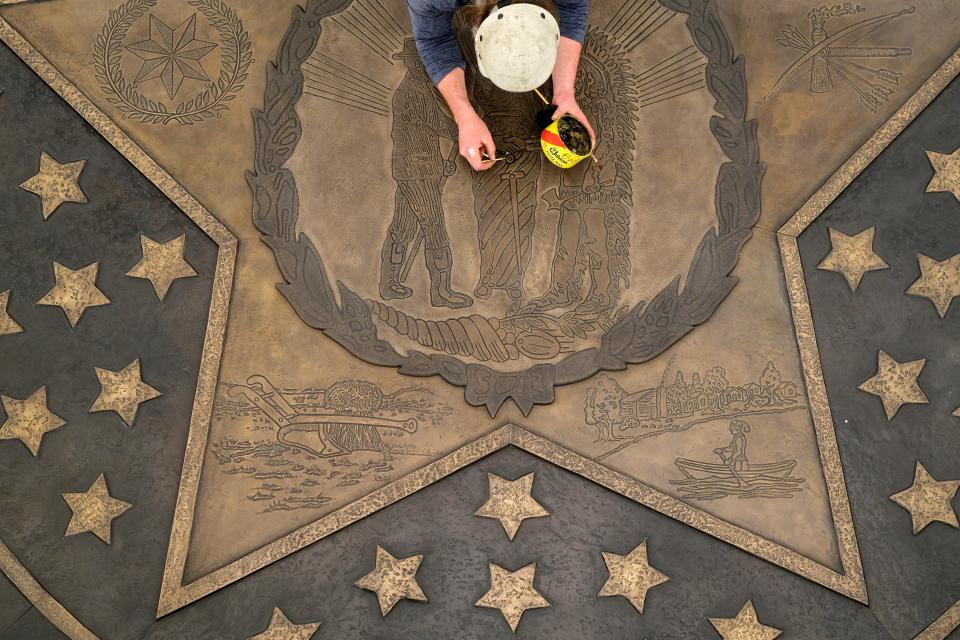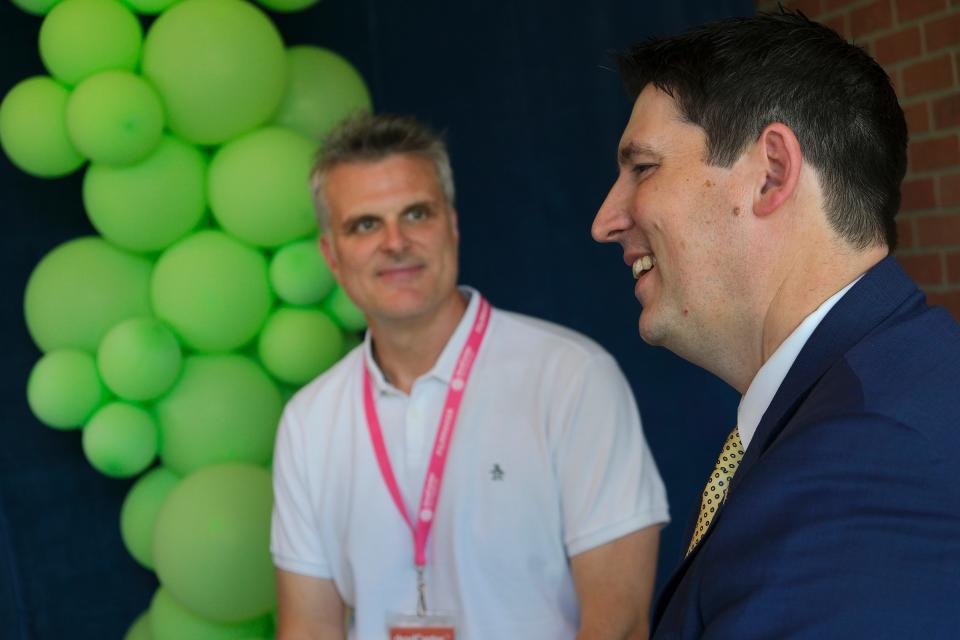'Temple of our democracy': Drone film 'The People's House' shows restored Oklahoma Capitol
In true Oklahoma fashion, Trait Thompson and Bryan Beasley were inspired by football — or at least a documentary series about football — when they came up with the idea of a four-minute drone tour of the state Capitol.
"The drone shot was really Trait's idea. He had seen 'Hard Knocks' on HBO, and they fly through the Dallas Cowboys practice facility. He comes to me and my producing partner and is like, 'I want to do something like this at the Capitol,'" said Beasley, a Los Angeles-based filmmaker who grew up in Oklahoma City.
"I remember talking to Jaime (Roman), my producer, and I'm like, 'Uh, I've never done anything like this before. How do we do it?' And she goes, 'We hire those people.' And that's what we did."
The drone tour in, through and around the recently revamped center of state government is the eye-catching centerpiece of the new short documentary "The People’s House: The Story of the Oklahoma State Capitol."

How does 'The People's House' celebrate a $280 million state project?
The fourth Oklahoma Historical Society documentary Beasley has directed, the short film celebrates the eight-year $280 million state Capitol restoration that was completed in 2022. Produced with support from the Inasmuch Foundation, "The People's House" spotlights the extensive work on the Capitol, which ranged from bringing the vast building up to code and revamping the electrical system to restoring decorative infrastructure and replacing furnishings and carpet.
"As the project was finishing up, I started thinking ... it's important that we tell the story of the Capitol," said Thompson, who became the Oklahoma Historical Society's executive director in 2021 after years of managing the Capitol restoration project.
"There's the brick-and-mortar part of the story, but there's also the philosophical part about 'Why do we have this place where we can go and try to change the fabric of our society?'"
Along with the single-take drone shot by Sky Candy Studios, the short documentary includes interviews with retired Oklahoma Historical Society Executive Director Bob Blackburn, former governors George Nigh and Frank Keating, and Marilyn Luper Hildreth, daughter of the late civil rights leader Clara Luper.
After premiering in June at the deadCenter Film Festival in downtown Oklahoma City, "The People's House" is showing at 7 p.m. Aug. 4 at Auditorium at The Douglass during the Doc OKC documentary festival and at 5:45 p.m. Aug. 5 at Enid's Gaslight Theatre during the FLY Film Festival.

Thompson and Beasley talked with The Oklahoman during deadCenter about the making of and plans for "The People's House":
Q: Why did you think the state Capitol would be a good subject for a film?
Thompson: This is the temple of our democracy. ... I meet people all the time who say, "I've never been to the Capitol before," or "I didn't know I could go in the Capitol," or "It was 40 years ago with my third-grade field trip that I went to the Capitol." And I always tell them, "You need to go to the Capitol because it's the story of us. It's the story of Oklahoma. And it's portrayed in the brick and the mortar and the marble in the building. And it's a testament to what we can do when we decide to do something grand together."
That's one of my favorite parts about the Capitol restoration story is we decided we were going to do something big and bold, and we weren't going to cut corners. We were going to spend what it costs to make it right. And sometimes in Oklahoma, we decide not to do that. But this is a testament to when we do it right, when we put the right resources into it, what we can get on the other side. I can scarcely walk through the building now without somebody pulling me aside and saying, "The building is wonderful. I'm so proud to be an Oklahoman."
Q: How do you make a film about a building interesting?
Beasley: Once we started really diving into the history, it started to visually pop in my head. That's always my first go-to: If I can't see it, I'm not going to be able to work on it. ... The film I had here at deadCenter last year is called "The Battle of Honey Springs," which is a Civil War film that's been installed at the actual battlefield (visitors center) in Checotah, Oklahoma.
That's one of my favorite films I've ever worked on, because it was a perfect mix of the history and the interviews, but then we had these awesome battle scenes that we got to reenact. ... Oklahoma history, just unto itself, is insanely fascinating.
Q: Can you talk about using animation and drones to share the history?
Beasley: In one of my favorite scenes in the movie, we recreate the groundbreaking. There was 5,000 people there. There's a few famous photographs, but there's one really great one with a pickaxe and the governor at the time is breaking the ground. I was like, "What if, in animation, we see this picture, but then we back up and we see the photographer and see all the masses?" ... So, we're teaching history with a visual, and the animation really did make the history come alive.
Thompson: One of my favorite scenes of animation in the whole film is you see the Capitol going up from the ground. And you see all the elements: you see the concrete, you see the stone, you see the trains come in, because there were train tracks laid right around the base of the building. To see the building being built right before your eyes ... I got chills.
Q: What were the logistics involved in flying a drone through the state Capitol?
Beasley: Sky Candy, they're out of Minnesota, they're amazing. We had the pluck them from Qatar, where they were shooting all the stadiums for the World Cup ... and they loved it because they'd never done anything as grandiose as the Capitol. They're used to doing stadium stuff.
We gave them the blueprints, and we're like, "Hey, is this gonna be a problem?" They're like, "We're used to flying through tiny doorways. This place is massive. This is great." ... It was a whole full day of prep for me, walking through the building (and figuring out) what we wanted to spotlight, what we wanted to see, how the drone would get through certain doorways.
Then, we had 12 PAs (production assistants) on walkie talkies, and everyone's just talking to each other and opening doors at the right time. ...
We cast 70 extras ... and we end with the governor signing a bill. One of the wonderful parts about being a director is you're going to see Trait standing behind the governor with his whole family, and then there's my dad and my brothers.
Thompson: Getting permission to do something like that takes a lot because the Capitol is this patchwork quilt of who owns what space and what you can do in the space. So, it's not just a matter of calling one person and saying, "Hey, can we do this?"
We literally had to get permission from the House, the Senate, OMES (Oklahoma Office of Management and Enterprise Services), DPS (Department of Public Safety), the Supreme Court. ... And we had to get it all coordinated on the same day. So, the House had to be empty, the Senate had to be empty, the Supreme Court had to not be in use. And then we had to be able to fly through the building.
Thankfully, August in the Capitol is a pretty slow time of the year, when we filmed this. All the keys ended up turning at once, it ended up working out, but it was a logistical nightmare.
Q: What's next for the film after its festival run?
Beasley: Our hope is that, eventually, this will play on OETA ... and then, they built a museum in the Capitol. So, the film will have a home there eventually.
Thompson: We'll have it on our YouTube page as well, so it'll be an educational resource. ... We're planning to use it in multiple different ways to be able to tell the story of this building and why it's important.
DOC OKC FESTIVAL
When and where: Aug. 4-6, Auditorium at The Douglass, 600 N High Ave.
"The People's House" screening: 7 p.m. Aug. 4.
Information: https://docokc.org.
ENID'S FLY FILM FESTIVAL
When and where: Aug. 4-5, Gaslight Theatre, 221 N Independence, Enid.
'The People's House' screening: 5:45 p.m. Aug. 5.
Information: https://www.facebook.com/flyfilmfestival
This article originally appeared on Oklahoman: Short film's drone tour of Oklahoma Capitol inspired by 'Hard Knocks'

